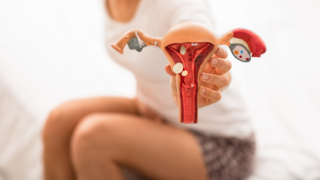In this article:
Skin tags and moles are usually minor and painless, but they can feel intrusive. Not because they hurt, but because they’re visible. Especially on Indian skin tones, where hyperpigmentation or raised textures may stand out more prominently. You might wonder if it’s normal. You might worry about skin cancer. You might feel pressure to remove them quickly for photos or comfort, but aren’t sure what’s safe.
Let’s break down what’s happening and how to navigate it without panic.
What Are Moles and Skin Tags, and Why Do They Appear More in Pregnancy?
Moles are clusters of melanocytes (pigment-producing skin cells), while skin tags are small, soft, benign growths that hang off the skin by a stalk. Both are generally harmless. But during pregnancy, hormonal shifts can make them grow, darken, or multiply.This is especially common in areas with friction, like the neck, armpits, under breasts, groin, or waistband zones.
- Skin tags (acrochordons) tend to pop up in folds where skin rubs against skin or clothing.
- Moles (melanocytic nevi) may become more noticeable or pigmented due to hormonal changes affecting melanin.
Why This Matters for Your Pregnancy and Postpartum Experience
Even when medically minor, this can carry psychological weight, especially when combined with other changes to your body and identity.- Friction and sensitivity: As your body changes, skin folds deepen and areas like the underarms, chest, or groin may see more rubbing, causing irritation or skin tag formation.
- Breastfeeding considerations: Moles or tags near the areola or breast may interfere with latching or cause discomfort later.
- Appearance concerns: For some, these skin changes affect confidence, especially during events or maternity photoshoots.
- Confusion with skin cancer: A growing or changing mole might raise fear about melanoma, even if it’s benign.
- Cultural discomfort: In some South Asian families, visible moles or ‘marks’ on the neck or face may be stigmatised or misinterpreted as signs of illness.
What Causes These Skin Growths During Pregnancy?
There are multiple factors at play when it comes to understanding the reason behind skin growths during pregnancy.- Hormonal fluctuations: Oestrogen and progesterone stimulate skin cell growth and melanin production. This can lead to darker, thicker moles or skin tags, especially in areas of movement or friction.
- Weight gain and skin folds: As your belly and breasts grow, skin folds increase. This creates warm, moist environments that favour skin tag formation, particularly in Indian climates.
- Increased blood flow and vascular changes: More blood circulation can cause raised, pigmented spots to become more noticeable.
- Genetic predisposition: If you had moles or skin tags before pregnancy, they may become more prominent. Some women are genetically more prone to skin growths.
- Ayurvedic insight: According to Ayurveda, pregnancy aggravates Pitta and Vata, affecting twak vikaras (skin disorders). Skin tags are often linked to excess heat, poor circulation, and dhatu imbalances in Rakta and Mamsa.
How Are Moles or Skin Tags Evaluated During Pregnancy?
Most diagnoses are clinical. Your dermatologist or gynaecologist can usually confirm whether a growth is benign by examining it visually.However, you should speak to a doctor immediately if you notice:
- Rapid change in size or colour
- Irregular borders or multiple colours
- Itching, bleeding, or crusting
- Painful or inflamed growths
Can You Treat or Remove Them During Pregnancy?
If the mole or tag is not suspicious or symptomatic, doctors usually recommend leaving it alone until after delivery. However, there are some safe, targeted approaches:- Cryotherapy (freezing): Safe in pregnancy for skin tags if they cause friction or discomfort.
- Cauterisation or surgical snipping: Also considered safe for small tags, but done only if medically necessary.
- Topical creams: Most over-the-counter mole removal creams or tag-drying gels are not pregnancy-safe. Avoid these.
- Home remedies: Avoid using vinegar, garlic, thread-tying, or online “DIY” methods. These can cause burns, infection, or scarring, especially with increased pregnancy sensitivity.
What Can You Do to Manage Skin Tags or Moles Safely?
You may not be able to prevent them entirely, but there are ways to reduce irritation or appearance changes:- Wear soft, breathable fabrics: Reduce skin friction with cotton or bamboo clothing, especially under bras or armpits.
- Use a fragrance-free moisturiser: Keep skin hydrated to reduce tag irritation.
- Gently clean areas prone to moisture: Especially in folds like under the breasts or belly.
- Avoid tight jewellery or neckline rub: Chains or bangles rubbing on tags may worsen irritation.
- Use mineral-based sunscreen: If your moles are exposed to the sun, protect them from UV darkening.
- Check monthly: Monitor for changes in size, shape, or colour, especially on breasts, groin, or face.
Moles and skin tags may be small, but the worry they bring can feel outsized, especially in a body already stretched by change. Most of the time, they’re just harmless souvenirs of the hormonal tide. But when in doubt, don’t guess. Get them checked. You’re allowed to ask questions, seek reassurance, and want to feel good in your skin, even while it transforms.
FAQs on Why Some Women Grow More Moles or Skin Tags in Pregnancy
- Will my moles and skin tags go away after delivery?
Some skin tags fall off on their own postpartum. Others may shrink, but many stay unless removed. - Are pregnancy moles a sign of skin cancer?
Most are benign. But always get any mole that rapidly changes, itches, bleeds, or has irregular borders checked by a dermatologist. - Can I use over-the-counter tag removers while pregnant?
No. These may contain harsh acids or ingredients unsafe during pregnancy. Stick to medical guidance. - Can these skin growths affect breastfeeding?
Only if they’re located around the areola and cause latch issues or irritation. In such cases, they may need evaluation.










